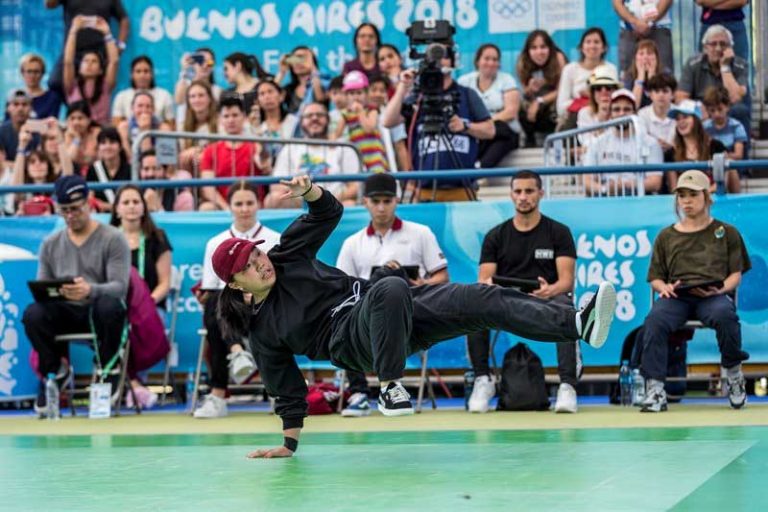
For FIBA 3×3 basketball the Paris 2024 Olympic Games represents a second chance for a first impression.
The urban, compact and fast-paced version of basketball made its debut at the postponed, fan-restricted Tokyo 2020 Olympics that were staged during the COVID-19 pandemic in 2021. Though fans were prohibited from the venue, some spectators managed to attend.
“There was an average of 100 people that somehow squeezed through security from other sports or other venues…,” FIBA’s managing director for 3×3 Alex Sanchez told GamesBids.com during an online interview.
Still the lack of spectators was a missed opportunity for the sport Sanchez admitted, tainting its first Olympic showcase.
But 3×3 at Paris 2024 is already a sellout with 4000 ticketed seats and standing room for each session, ensuring that the tournament will be a “major success.”
“The main difference [in Paris] is the spectators,” Sanchez said.
“The venues are designed for the spectators to be really close to the action, but something we are really proud of is our intimate setting where the first row of spectators is actually a meter away from the bench of the players so this intimate setting creates a special bond between players and the audience that is really difficult to get in other stadiums that are big.
“We usually play in very iconic downtown locations.
“The athletes are used to people very close and sometimes when we play in urban environments there are a lot of people standing very close and sometimes even touching the athletes.”
3×3 will be staged at Place de la Concorde in central Paris, sharing the urban park environment with BMX freestyle, skateboarding and the inaugural appearance of breaking (breakdancing) at the Olympics. Further amplifying the electric atmosphere, a DJ hosts the experience pumping non-stop music.
“We are the only sport that has music mostly non-stop,” Sanchez said, further explaining that other sports stop the music during play.
“I’m looking forward to proving that we are very modern and athletic product,” Sanchez said.
Since Tokyo, dedication to the discipline by athletes has grown with many professionals now earning a living with 3×3.
“If you look at the top teams in our World Tour, [they] are actually professionals that don’t discontinue playing basketball but they are committed to 3×3,” Sanchez explained.
“They have staff, they have coaches and physical therapists. Some of the top teams even have mental coaches because 3×3 – in the way it is created – is very attractive to the spectators but is very stressful for the athletes because basically every game, every weekend is a knockout game, you need to win to get money, you need to win to progress so there is constant stress and tension on the athlete.”
The result has been an improved product on the court that has attracted more mainstream attention. The latest World Tour Final held in Jeddah, Saudi Arabia in October was the most attended edition ever with almost 40 broadcasters covering the event. Last year FIBA struck a two-year deal with European broadcaster Eurovision Sport to provide free-to-air coverage of events and qualifiers leading up to Paris 2024.
The deal leverages exposure on broadcasters’ social media channels and ties in with the FIBA 3×3 digital marketing strategy for growth ahead of the Olympics and beyond.
“You have to constantly generate attractive content to keep people following you so the churn in social media is significantly higher than TV,” Sanchez said.
“We are very proud of our social media numbers, the followers have more than doubled across the majority of our platforms compared to last year and the views are 1.1 billion so if you compare with athletics or badminton or table tennis you will see that our numbers are really strong, they are basically top five.
Youth appeal and gender equity make 3×3 attractive to the International Olympic Committee (IOC) which could help keep the discipline on the Olympic program for years to come.
Last year the IOC added five sports to the Los Angeles 2028 Games – four of them team sports – and that propelled the expected number of athletes well beyond the quota of 10,500 mandated in the Olympic Charter. Sometimes sports already on the program are asked to eliminate events or disciplines to help meet the overall quota.
Breaking, another urban sport that is popular among youth, was overlooked completely for inclusion in Los Angeles meaning its debut in Paris might also be its finale.
But Sanchez remained confident that 3×3 will remain on the 2028 program after the details are worked out later this year.
“We are confirmed as a discipline for LA, we are discussing now a potential venue, so from that perspective we are not worried at all.
“LA is basically an outdoor city,” he said, pointing to the temporary open air venue offered by the 3×3.
“LA is a basketball city, remember they have two NBA teams [LA Lakers and LA Clippers], so I think we’re looking forward to a major success in Los Angeles.”
Olympic 3×3 basketball will hit the court in front of a packed house July 30 and run until August 5.


